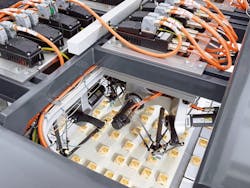How IP67 and IP69K components affect machine-design decisions
- How do the quickly changing consumer trends affect the design, form and function of packaging machinery?
- How do packaged goods manufacturers approach retrofitting?
- How is industry addressing the shortage of experienced technical employees?
- How much importance should the packaging equipment industry place on the IIoT and the productivity gains that big data promises?
As more equipment comes out of the cabinet and on the line where intelligence is needed, how will IP67 and IP69K components affect machine-design decisions?
Jim Hulman | process, packaging, printing, converting—business development manager, Bosch Rexroth
On-machine solutions are already designed to IP67 and IP69K. There are many benefits to on-machine solutions (Figure 8). Primarily, with the elimination of the floor-mounted drive/control cabinet, end users are able to better utilize manufacturing floor space. Integrated motor/drive technology, and now on-machine drive power supplies, allow cabinets to be machine-mounted or eliminated. Cabinets become easier to service because high voltage is easier to isolate. This same technology reduces OEM assembly costs by replacing power and feedback cables with a single hybrid cable. The simplicity of this design also reduces machine installation time/cost by reducing the number of cable and wiring mistakes between a machine and floor mounting cabinet.
Figure 8: With the elimination of the floor-mounted drive/control cabinet, end users are able to better utilize manufacturing floor space.
(Source: Bosch Rexroth)
As for high-protective-rated devices, we are certainly seeing more HMI, I/O and motion systems coming out of the cabinet and requiring IP67 to IP69K ratings. Track systems themselves are already available in food-grade, washdown configuration.
We use them extensively, given the nature of what we do.
ALSO READ: The future of packaging machinery design
Mike Bacidore is the editor in chief for Control Design magazine. He is an award-winning columnist, earning a Gold Regional Award and a Silver National Award from the American Society of Business Publication Editors. Email him at [email protected].










